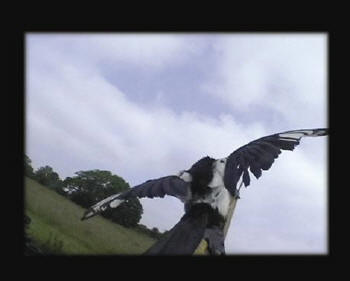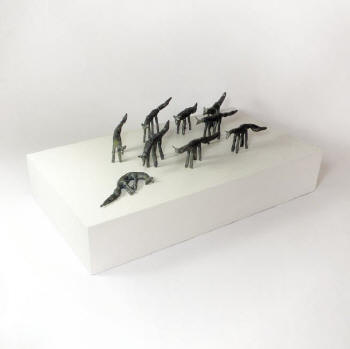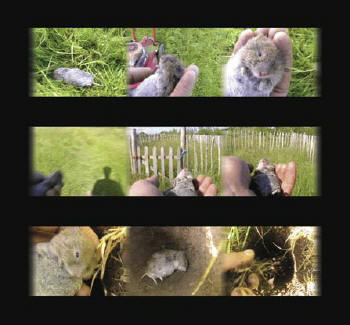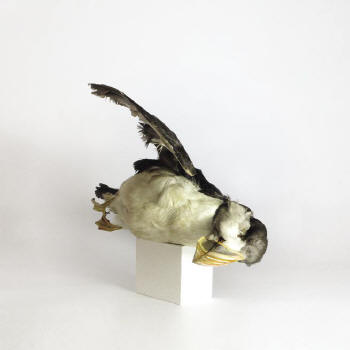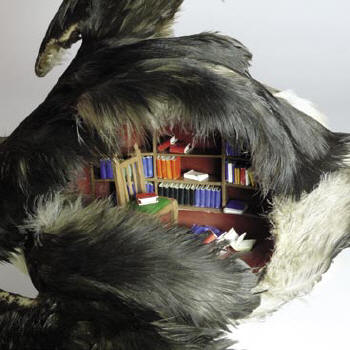|
|
| home | features | exhibitions | interviews | profiles | webprojects | gazetteer | links | archive | forum |
|
Dark Ecologies: Reflections on Paul Chaney at Goldfish Robin Mackay
The first work encountered in the show, visible from Penzance’s increasingly faux-swanky Chapel Street, is the video One for Sorrow (right) in which the camera operator – presumably Chaney himself – ‘re-enacts’ the final flight of a dead magpie by affixing it to a stick and propelling it around a field. That’s so, like, offensive, yeah? Realistically, however, Chaney’s work will offend only those determined to be offended in order to elicit conservative solidarity. It will ‘disturb’ only those for whom ‘disturbing’ is a comfortable aesthetic category designed to reassure themselves of the fortitude of their own cosmopolitan sensibility. In fact One For Sorrow is a perfect example not only of the mix of the grotesque and the tender that characterises the works on show here, but also of the sharp interrogative edge that the thoughtful viewer will easily discover below this surface. In his
book Ecology Without Nature,[1]
Timothy Morton suggests that much reflection on the ecological and
environmental is ultimately self-undermining: Expending much energy on
evoking the glory of Nature as it might be without the intervention of
humans and their divisive articulations, it attempts to erase its own
status as discourse or inscription. But the most desperate attempts by
artists and writers alike to allow a continuous, virgin and untamed
nature to speak through them, unmediated, ultimately constitute only
more mediation. Along with eco-writing, much ‘environmental’ art is
afflicted by this willed obliviousness to the
Nothing expresses this more pointedly than Chaney’s touching sculpture Memorial to Roadkill Foxes (left), in which a skulk of foxes peer uncertainly and gloomily at one of their number laid out by a passing car. This scene is immediately moving, but takes a terrible turn when one learns that the simply but expressively sculpted animals are reprocessed car wheel balancing weights. The subversion of content by material is of course a commonplace in contemporary art, but Chaney’s own vacillating sensitivity to both sides of the thought is palpable, preventing the work’s irony from sliding either into hectoring eco-admonishment or grizzled cynicism. Mourning and guilt are forged of the same stuff, it says; What makes it possible to conceive of ‘nature’ also makes it inevitable that we have already betrayed it. But, following Morton’s thesis, if this is The Fall, then Eden is nothing but writing’s own retroactive myth of origin, its fantasy of self-effacement. The outcome of Morton’s deconstructive reading[2] is that ecology can only attain maturity in becoming an ecology without nature. The inextricability of the two elements in Chaney’s sculpture invites us to desist from simultaneously exalting an untouched nature and excluding ourselves from it.
As
well as Chaney’s hand-drawn map of the Field Graveyard in which
such casualties are laid to rest, the show also includes a number of
other works on paper which show various in-progress interrogations of
One of
the most complex and most striking works in the show, The Library at
St Kilda (pictures below x2), indicates new directions for Chaney’s
practice, deploying the same problematising spiral as the earlier works
but in more ramified and complex directions. It consists of a puffin
recovered from the coast of St Kilda, a tiny island whose last
inhabitants were evacuated in the 1930s after their indigeneous culture,
isolated for centuries, had been blighted by missionaries and diseases
from the mainland. The bird’s back yawns open to reveal a
perfectly-sculpted miniature library. It couldn’t be any clearer: The
artist can no more escape it than the writer can: the body of
the‘natural’ caves in, splits open, and the entrails of language smile
out. Everybody loves a Puffin, the subtitle tells us, but the
work leaves us in no doubt that an apparently simple love of nature is
the surface manifestation of a conceptual treasury, a literary legacy, a
cultural history. For those contemporary with Chaney, who thus grew up
with the junior imprint of British publishers Penguin, ‘Puffins’ will
already be books. But the work’s visceral interpenetration of nature and
knowledge cuts in yet other ways. The island of St Kilda itself is
recognised by naturalists as a special case: Its isolation meant that
the interplay between human culture and animal life transpired as if in
a controlled experiment, species waning and even becoming extinct in
symbiosis with the transformation and decline of its human culture.
A few words should be said about the curation of the show. So often, art in Cornwall plays second fiddle not only to tourism but also to thinly-veiled real-estate avarice. When the principal reaction to art is to remark on the ‘lovely space’ that contained it, I reach for my shotgun. As luck would have it, Goldfish consists of a vertical set of pleasant, but smallish and rather difficult spaces. Joe Clarke, the proprietor, obviously has the measure of the place and has made a virtue of the arrangement, employing it to great effect precisely by using it to promote the work rather than itself. The decision to present a sparing selection of pieces deprives the viewer of the easy option of skimming over the work, registering it as a generality. Instead it gently impels them to approach and focus fully upon each of the works in turn. Such discreet minimalist presentation is perversely effective: Antiseptically encapsulated in their perfectly neat cases, as the viewer draws near, the pieces yield their difficult, messy contents slowly and insidiously. This sequence is particularly effective with Goodbye Old Man, a miniature diorama made in the style of a railway-modeller, which seems at first to depict the bracing spectacle of a rustic type surveying his (extremely) smallholding. On closer examination it also harbours a disgruntled farmer, concealed in the trees, shotgun trained on the unfortunate peasant. Land is always property, territory, and the locus of a barely-suppressed warfare, as the work’s subtitle (In respect of the need for field defences) seems to suggest. But which is Chaney, blameless cultivator or jealous aggressor?
‘The Lonely Now’ is both a confirmation of Goldfish’s importance as a gallery that dares to take risks and to promote work that belongs to our uncertain present and future, and of Paul Chaney as a truly challenging and original artist making such work. Chaney succeeds in repositioning ‘cognitive dissonance’ – our strange collective inability fully to take on as living reality what we ‘know’ about climate change – as a symptom of the more profound bad faith of what Morton calls ‘ecologocentricism’ – the continuous and futile effort to expunge from nature ‘itself’ the human marks that circumscribe and constitute it as such. Through this insight, we can understand our continual evasion and prevarication on environmental matters as a symptom of the resistance of common sense to something truly difficult to think, a resistance that will not be overcome by any amount of green goodwill, ‘holistic’ or ‘intuitive’ paradigm shifts. What is difficult is to rethink ecology by admitting that its logos is always already recoded, messed up, unnatural; to rebuild it as an ecology of (perhaps uncomfortable) co-existence and intervention, an ecology which, in Morton’s words, ‘may be without nature. But it is not without us.’. This is the future Chaney’s work seems to bear us towards, plunging us into strange situations, emotions and perceptions that expose us to the urgency and complexity, not to mention the humour and the irony, of the problem at hand. [1] T. Morton, Ecology Without Nature: Rethinking Environmental Aesthetics (Cambridge, Mass.: Harvard University Press, 2007). [2] ‘Just as Derrida argues that logocentrism underlies Western philosophy’s attempt to ground meaning in an essential form, I hold that ecologocentrism underpins most environmentalist philosophy, preventing access to the full scope of interconnectedness.’ – Timothy Morton, http://www.rc.umd.edu/blog_rc/?tag=timothy-morton . [3] Charles Maclean, St Kilda: Island on the Edge of the World. (London:Tom Stacey, 1972; revised edition Edinburgh: Canongate, 1998), 98-9.
|
|
|

